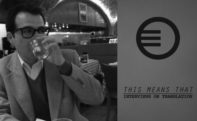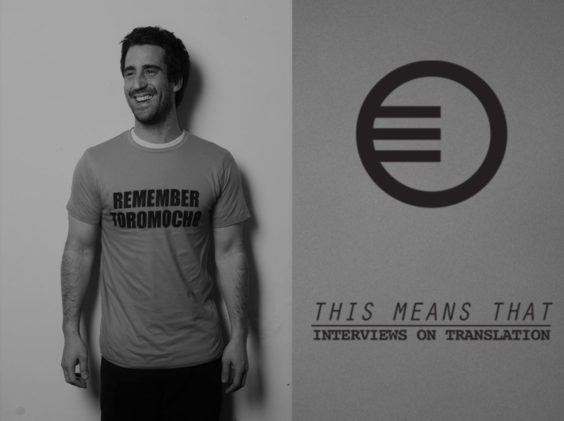
Por Interview by Brenda Lozano, Spanish to English Translation by Ana Isabel Martínez

Brenda Lozano: What book or story led you to English?
José Antonio Villarán: Dr. Seuss’ books were always around in our house, they definitely led me to English. I’m the third of four siblings, we were born in different countries and lived somewhere in the liminal space between the Spanish and English languages, between Perú, México and the United States. We would recite them to each other by heart and tweak the lines as if playing a game. Roald Dahl’s books also did their part.
Tell us about your first translation.
My mom (born in México, raised in Texas) was a teacher, we were living in Perú at that time, and she wanted us to be truly immersed in the English language, so she labeled every single object in our house. I was born into that. Ever since I can remember, I understood life through something like a constant state of translation. The first book translation project I did was a case study on human rights violations during the Shining Path years in Tambo, Ayacucho, by Jemima García-Godos, from English to Spanish.
Is translation a way to get closer or a way to move away from the original text?
I would say something like both, and at the same time, which is kind of impossible. I think of translation as an act of making, an act of creating, and in that light I see it as something poetic, closer to an art than a science. When I’m translating, I feel like I need to do both: get close to the work and be traversed by it, to then perhaps find the adequate distance to re-create it in a different language.
How faithful are you to the original? How would you describe this fidelity, as being more literal, more conceptual?
I try to be as faithful as I can, and I understand this fidelity as not only taking into account the text’s semantic meaning, but also its musicality, its tone and cadence, the way it responds to a specific historical context, etc… So I guess more conceptual. And perhaps this seemingly apparent binary = literal/conceptual can be seen instead as a complex relation, as an intricate dance, as a way to get closer and move away at the same time.
Is there a metaphor, some lines or verses that depict your idea of translation?
I can think of some lines by Derrida, Deleuze or Anzaldúa, but I don’t know if they actually capture my own idea of translation. Perhaps I just haven’t figured it out yet.
Does translation exist only within the confines of language or are there other forms of translation whose materiality aren’t words?
Well, is translation defined only as a linguistic operation? (I certainly hope not) Or can it perhaps be understood more broadly? I’m thinking here of music and visual art, and the processes that occur between different social media and virtual platforms that you could call translation. I’m also thinking of interspecies communication; how does the wasp translate/codify the necessary information in order to engage with the orchid? Can this be defined as a process of translation as well? (I certainly hope so) I think everything exists in something like a constant state of translation.
Brenda Lozano: ¿Qué libro o qué historia te llevó al inglés?
José Antonio Villarán: Los libros del Dr. Seuss siempre estaban en casa y definitivamente me llevaron al inglés. Soy el tercero de cuatro hermanos, todos nacimos en distintos países y vivimos en ese espacio liminal entre el español y el inglés, entre Perú, México y los Estados Unidos. Los recitábamos, de memoria, entre nosotros y ajustábamos las frases como si fuéramos jugando un juego. Los libros de Roald Dahl también nos influyeron.
Háblanos de tu primera traducción.
Mi mamá (nacida en México, criada en Texas) fue maestra, en ese tiempo vivíamos en Perú, y ella quería que estuviéramos verdaderamente inmersos en el idioma inglés, así que ella le ponía etiquetas a cada objeto en nuestra casa. Yo nací con eso. Desde que puedo recordar, entendí la vida a través de algo como un estado constante de traducción. El primer proyecto de traducción de libros fue un estudio sobre violaciones de derechos humanos durante los años de Sendero Luminoso en Tambo, Ayacucho, escrito por Jemima García-Godos, del inglés al español.
¿Es la traducción una forma de acercarse o una forma de alejarse del texto original?
Yo diría que ambos, y que ocurren simultáneamente. Aunque eso es algo casi imposible. Pienso que la traducción es un acto de hacer, un acto de crear, y en ese sentido lo veo como algo poético, más cerca a un arte que a una ciencia. Cuando estoy traduciendo, siento que necesito hacer ambas cosas: acercarme a la obra y ser atravesado por ella, para luego quizás encontrar la distancia adecuada para recrearla en un idioma diferente.
¿Qué tan fiel eres al original? ¿Cómo caracterizarías esa fidelidad, ¿más literal, más conceptual?
Trato de ser lo más fiel que pueda, y entiendo que esta fidelidad no sólo tiene en cuenta el significado semántico del texto, sino también su musicalidad, su tono y cadencia, su forma de responder a un contexto histórico especifico, etcétera. Así que supongo que es más conceptual. Y tal vez este aparente binario = literal / conceptual, se puede ver, en cambio, como una relación compleja, como un baile complejo, una manera de acercarse y alejarse al mismo tiempo.
¿Hay alguna metáfora, algunas frases o versos que retraten tu idea de la traducción?
Me vienen a la mente algunas líneas de Derrida, Deleuze o Anzaldúa, pero no sé si realmente capturan mi propia idea de traducción. Quizás aún no la he descubierto.
¿La traducción sólo existe en los confines del lenguaje o hay otras formas de traducción cuyo material no sean las palabras?
Bueno, ¿se define la traducción sólo como una operación lingüística? (ojalá que no). ¿O quizás se podría entender en un sentido mas amplio? Pienso aquí en la música y el arte visual, y los procesos que ocurren entre diferentes medios sociales y plataformas virtuales que se pueden llamar traducción. También pienso en la comunicación entre especies; ¿cómo la avispa traduce/codifica la información necesaria para involucrarse con la orquídea? ¿Se puede definir esto como un proceso de traducción también? (ojalá que sí) Creo que todo existe en algo así como un estado constante de traducción.
Jose Antonio Villarán was born in Lima, Perú. He is the author of two books of poetry, la distancia es siempre la misma (Matalamanga, 2006) and el cerrajero (Album del Universo Bakterial, 2012). In 2008 he created the AMLT project, an exploration of hypertext literature and collective authorship; the project was sponsored by Puma from 2011-2014. His third book, titled open pit, is forthcoming from AUB (Lima). He holds an MFA in Writing from the University of California-San Diego, and is currently a PhD student of Literature at the University of California-Santa Cruz.
Brenda Lozano was born in Mexico City. A narrator and essayist, she contributes to Letras Libres and Día Siete, among other publications. Her newest work, Como piensan las piedras, was released in 2017 by ALFAGUARA. She is the Spanish Language Editor for MAKE Magazine and Co-Director of the Lit & Luz Festival.
Kenneth Guay is from New York. He has a Masters degree in English from Marquette University in Milwaukee and is currently the Assistant Managing Editor at MAKE Magazine.
José Antonio Villarán nació en Lima, Perú. Es el autor de dos libros de poesía, la distancia es siempre la misma (Matalamanga, 2006) y el cerrajero (Album del Universo Bakterial, 2012). En 2008 creyó el proyecto AMLT, una exploración de literatura de hypertext y autoridad colectiva; el proyecto fue patrocinado por Puma de 2011-2014. Su tercer libro, open pit, viene por AUB (Lima). Villarán tiene un título de Maestría de Artes Finas de la Universidad de California-San Diego y está matriculado en el programa de doctorado en Literatura de la Universidad de California-Santa Cruz.
Brenda Lozano nació en la ciudad de México. Es narradora and ensayista. Colabora con Letras Libres y Día Siete, entre otras publicaciones. Su libro, Como piensan las piedras, fue publicado en 2017 por ALFAGUARA. Es editora para MAKE Magazine y también es Co-Directora del Lit & Luz Festival.
Kenneth Guay es de Nueva York. Tiene una Maestría en literatura de la Universidad de Marquette en Milwaukee y es Asistente del Editor Gerente de MAKE Magazine.















click to see who
MAKE Magazine Publisher MAKE Literary Productions Managing Editor Chamandeep Bains Assistant Managing Editor and Web Editor Kenneth Guay Fiction Editor Kamilah Foreman Nonfiction Editor Jessica Anne Poetry Editor Joel Craig Intercambio Poetry Editor Daniel Borzutzky Intercambio Prose Editor Brenda Lozano Latin American Art Portfolio Editor Alejandro Almanza Pereda Reviews Editor Mark Molloy Portfolio Art Editor Sarah Kramer Creative Director Joshua Hauth, Hauthwares Webmaster Johnathan Crawford Proofreader/Copy Editor Sarah Kramer Associate Fiction Editors LC Fiore, Jim Kourlas, Kerstin Schaars Contributing Editors Kyle Beachy, Steffi Drewes, Katie Geha, Kathleen Rooney Social Media Coordinator Jennifer De Poorter
MAKE Literary Productions, NFP Co-directors, Sarah Dodson and Joel Craig